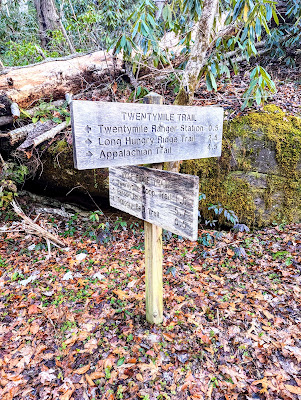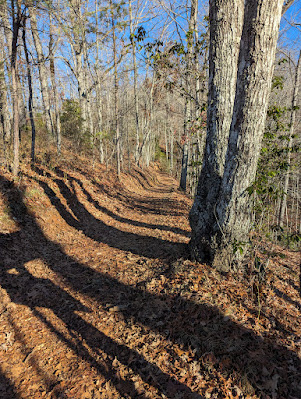
The road to nowhere ends right here. It is also known as Lakeview Drive. The tale of this road is a contentious one for the folks of Swain County North Carolina. When the Tennessee Valley Authority built Fontana Dam backing up the Little Tennessee River in the early 1940s, old Rt 288 was flooded. Rt 288 connected several towns - Bushnell, Judson and Proctor. These towns were either submerged or access to them was submerged. All the residents in the area had to move. The Department of the Interior bought their land either willingly or by force. The Dept of the Interior facilitated the building of the dam to create a large source of hydroelectric power needed for wartime projects. Alcoa which made aluminum for aircraft and Oak Ridge and its secret Manhattan Project were two of the beneficiaries. TVA, which is a federally owned electricity corporation, was to pay Swain County for flooding Rt 288 and buy 44,000 acres to facilitate the dam and lake. Much of that acreage was transferred to the national park. And, the Dept of Interior was to build a road along the north shore of the lake to allow former residents to visit ancestral gravesites.
Construction of the road began just after the war in 1946. By 1971, only 7 miles had been completed. It turned out to be much more costly than thought. Eventually, an environmental issue was cited as the cause of abandoning the project. Anakeesta rock in the area is quite acidic and exposing the rock would cause acid runoff into streams affecting aquatic life and water quality. That did not go over well with Swain County. The only way former residents could visit gravesites was by boat and then hiking to cemeteries. The National Park Service paid for these visits a couple times a year.
Eventually, the Department of the Interior paid Swain County for reneging on the road. A settlement was reached in 2010. The USDI was to pay the county $52 million. However, it was given to the state of NC to manage and Swain County would only receive the interest on an annual basis. The final payment to the state was completed in 2018.
This has to be the most graffitied place in North Carolina or any National Park. The tunnel is about 1/4 mile long. Virtually every square foot of the sides of the tunnel have been painted.
Both sides are like this the entire length. At the other end, the tunnel entrance has been tagged as well as many trees above the entrance.
This is the unfinished end of the tunnel. The wooden guardrails are still in place and resemble those on the Blue Ridge Parkway. There is a turn around here and then just an old woods road, the former Rt 288.
Grading on the hillside
Strange metal trail sign
The lake is drawn down in the fall to anticipate the wetter months of Winter. I got a glimpse of that here on the Goldmine Trail.
My hike was on the Tunnel Bypass Trail and Goldmine Trail and then an out and back on Lakeshore Trail.





















































